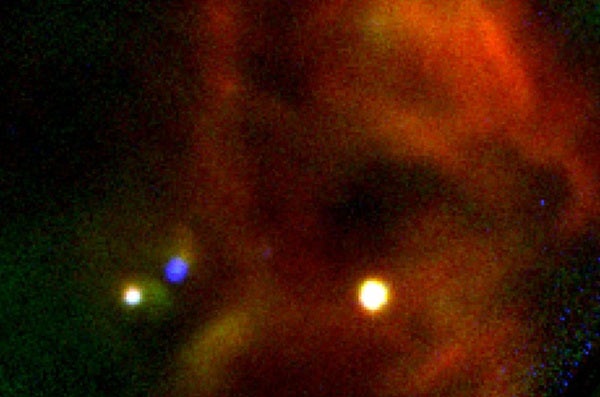The W40 image was taken by the Faint Object infraRed Camera for the SOFIA Telescope (FORCAST) instrument mounted in the airborne observatory — a highly modified 747SP airliner carrying a reflecting telescope with an effective diameter of 100 inches (2.5 meters). The image of W40 is a composite of data captured by the FORCAST camera at infrared wavelengths of 5.4, 24.2, and 34.8 microns, all of which are partially or completely blocked by water vapor in Earth’s atmosphere and inaccessible to observatories even on high mountain tops.
W40 is difficult to view with optical telescopes because it lies on the far side of a dense cloud of gas and dust. Infrared observations of the region peer through the dust to reveal a bright nebula, dozens of young stars, and at least six massive stars some six to 20 times the mass of the Sun forming at the center.
At least 50 percent of the stars in the Milky Way Galaxy formed in massive clusters of thousands of stars similar to W40. Evidence suggests that the solar system developed in such a cluster almost five billion years ago. Because stars are relatively dim at the wavelengths measured by FORCAST, the observed emission in the images is due to dust surrounding the stars that are heated to a few hundred degrees.
The W40 image was taken by the Faint Object infraRed Camera for the SOFIA Telescope (FORCAST) instrument mounted in the airborne observatory — a highly modified 747SP airliner carrying a reflecting telescope with an effective diameter of 100 inches (2.5 meters). The image of W40 is a composite of data captured by the FORCAST camera at infrared wavelengths of 5.4, 24.2, and 34.8 microns, all of which are partially or completely blocked by water vapor in Earth’s atmosphere and inaccessible to observatories even on high mountain tops.
W40 is difficult to view with optical telescopes because it lies on the far side of a dense cloud of gas and dust. Infrared observations of the region peer through the dust to reveal a bright nebula, dozens of young stars, and at least six massive stars some six to 20 times the mass of the Sun forming at the center.
At least 50 percent of the stars in the Milky Way Galaxy formed in massive clusters of thousands of stars similar to W40. Evidence suggests that the solar system developed in such a cluster almost five billion years ago. Because stars are relatively dim at the wavelengths measured by FORCAST, the observed emission in the images is due to dust surrounding the stars that are heated to a few hundred degrees.










